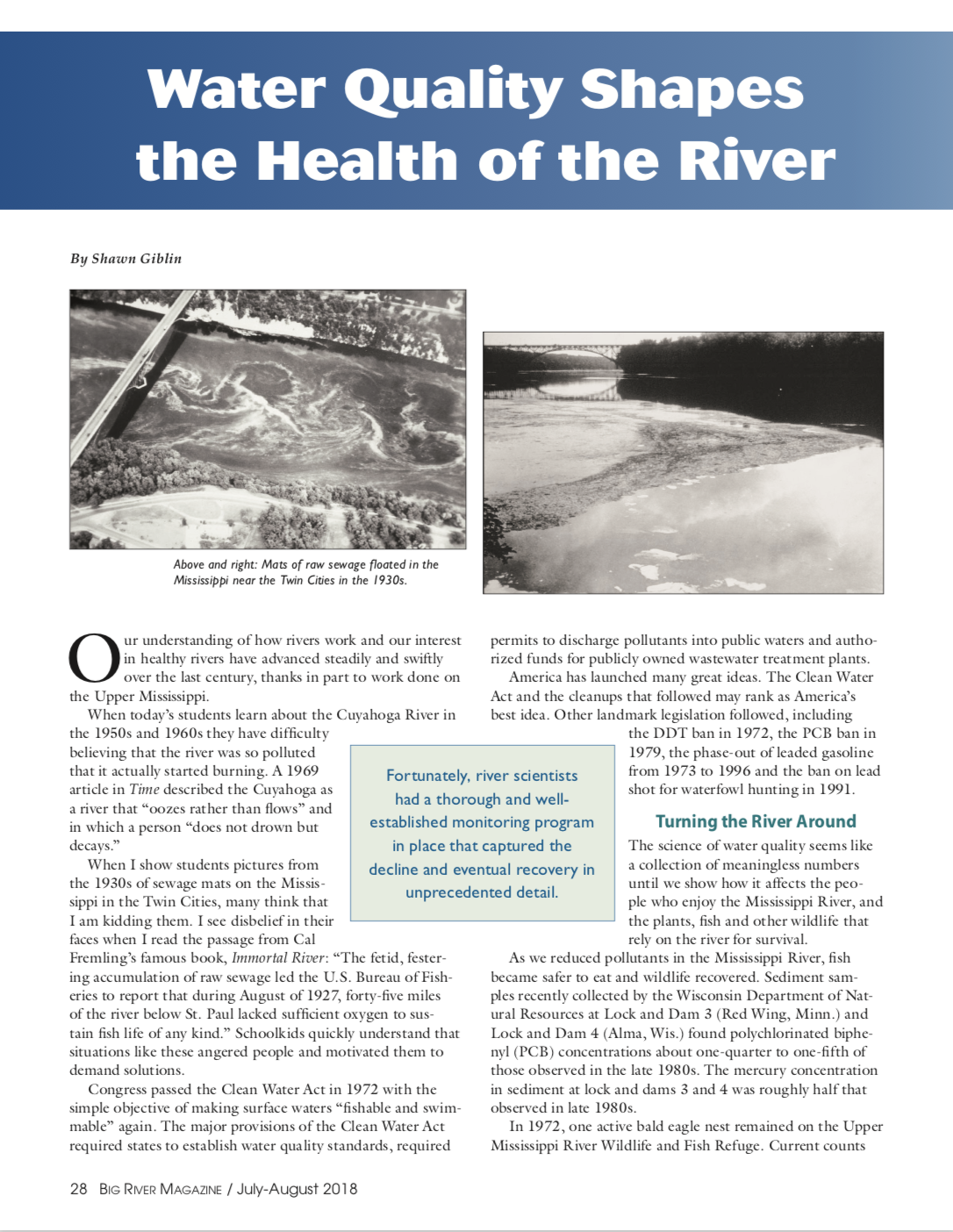June 20th, 2019, Spectrum West, Wisconsin Public Radio
LPLA interview starts at 15min 40 sec!
Read MoreYour Custom Text Here
June 20th, 2019, Spectrum West, Wisconsin Public Radio
LPLA interview starts at 15min 40 sec!
Read MoreBy: Steve Gardiner, Rivertown Multimedia; February 5, 2019
Read MoreBy: Minnesota Public Radio, January 13, 2019
Read MoreBy: Republican Eagle, September 19, 2018
Read More
By: Shawn Giblin, WI DNR
Published in: Big River Magazine / July-August 2018
Our understanding of how rivers work and our interest in healthy rivers have advanced steadily and swiftly over the last century, thanks in part to work done on the Upper Mississippi. When today’s students learn about the Cuyahoga River in the 1950s and 1960s they have difficulty believing that the river was so polluted that it actually started burning. A 1969 article in Time described the Cuyahoga as a river that “oozes rather than flows” and in which a person “does not drown but decays.”
When I show students pictures from the 1930s of sewage mats on the Mississippi in the Twin Cities, many think that I am kidding them. I see disbelief in their faces when I read the passage from Cal Fremling’s famous book, Immortal River: “The fetid, fester- ing accumulation of raw sewage led the U.S. Bureau of Fisheries to report that during August of 1927, forty-five miles of the river below St. Paul lacked sufficient oxygen to sustain fish life of any kind.” Schoolkids quickly understand that situations like these angered people and motivated them to demand solutions… (Download Full Article)
Rochester Post Bulletin, 3/8/2018
Author: Mac Becco (formerly Consoer), Lake Pepin Legacy Alliance
Like many waters in southern Minnesota, it is impaired by excess sediment and phosphorus, both of which threaten cascading impacts that could eventually lead to ecological collapse. Sediment accumulation is a particular concern since it is causing social impacts, such as reduced accessibility to upstream areas and adjacent communities.
A sustainable solution will require upstream mitigation, but local restoration is also necessary to manage the cumulative impacts and sustain current uses on the lake.
Read MoreRed Wing Republican Eagle, 1/11/2018
Author: Sarah Hansen, RW Republican Eagle
A decade ago, neighbors living in the beautiful riverfront community of Wacouta began to notice that their island was growing.
Sediment had collected on its shores and was increasing the footprint of the small island in the bay. Down river, sediment collected in the bed of Lake Pepin as well.
By 2009 these concerned residents were heavily involved in the sediment runoff issue — so much so that they organized to form the nonprofit Lake Pepin Legacy Alliance. Since then, the aim of LPLA has been to save this beloved and geographically unique body of water from further pollution.
Read MoreRed Wing Republican Eagle, 3/10/2018
Author: Mac Becco (formerly Consoer), Lake Pepin Legacy Alliance
As reported by Lake Pepin Legacy Alliance, boat groundings in upper Lake Pepin reached an all-time high last summer. Some readers commented that the danger is most formidable for visiting and infrequent boaters. While accurate, the rest of us aren’t immune from the underlying ailment facing Lake Pepin. Sedimentation is nearing ecological and social tipping points that will be disastrous for everybody. It’s time for us to heed the warnings and mobilize together for action.
Read MoreLPLA Executive Director, Rylee Main, is the special guest on The Boating Show with Wolf Marine Inc. and Tetzlaff Yacht Sales. The episode provides a great overview of sources of sediment, local impacts, and ways to help.
Read MoreLake Pepin Legacy Alliance
PO Box 392, Red Wing, MN 55066
Phone: 651-327-0854
Email: info@lakepepinlegacyalliance.org
LPLA is a 501(c)3 organization and all donations are tax-deductible to the extent allowable by law. EIN: 27-0573238